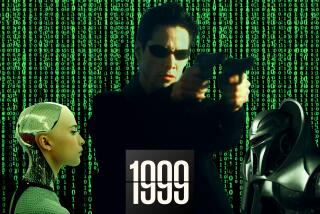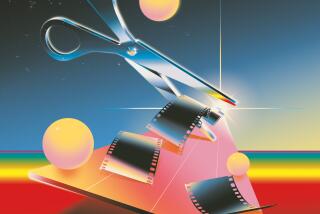For ‘Blade Runner 2049,’ cinematographer Roger Deakins only had to film the future

“I jog on the beach every morning — except today because I had a hangover,” says Roger Deak-ins, on the morning after the world ‘premiere of “Blade Runner 2049.”
What’s Deakins also feeling besides post-celebratory? “Relief,” says the English cinematographer known for his breathtaking, painterly style as well as his advice-filled blog, Looking at Light. “It’s two years of your life. You’ve got to be a bit nervous.”
Indeed, one of the first things that “Blade Runner 2049” director Denis Villeneuve did after landing the gig to helm the follow-up to Ridley Scott’s 1982 neo-noir classic was to summon the lanky, white-haired 68-year-old Deakins to Montreal to brainstorm, an essential phase of their collaboration that Villeneuve refers to as “Deakinizing.”
Over the course of his roughly 40-year career, Deakins has received 13 Academy Award nominations, including for “The Shawshank Redemption” and “No Country for Old Men.” But the scope and dark beauty of “Blade Runner 2049,” his first venture into epic-scale sci- fi, has everyone predicting that this time Deakins will return from the Oscars to his Santa Monica home with a trophy.
WATCH: Video Q&A’s from this season’s hottest contenders »
You had 92 days to shoot a film packed with explosions, sweeping apocalyptic landscapes and a love scene involving a holographic girlfriend. Talk about Day 1.
We started shooting in a forest where a girl is altering beetles with a strange machine that looked like a focus puller’s [tool]. It was late summer and we needed the greenery — it’s the only piece in the film that we wanted to look really beautiful. After that, we shot a blue-haired naked woman painted pink who is having a conversation with Ryan [Gosling]. It was funny, the kind of stuff that made us go, “What is this film we’re making?” [laughs]
True or false? The red dust Vegas sequence was inspired by a strange climatic event that descended upon Sydney, Australia, in 2009.
Actually, it was two things. Once, I was in Egypt in the middle of a haboob, which is an intense, dead red dust storm that comes out of the Sahara. Then I also remembered the dust storm in Australia, so we just got images off the web of these different situations and used them as a sort of template.
Why does the Elvis Presley malfunctioning hologram scene work so well?
We had a really brilliant Elvis double. Not that I was ever an Elvis fan. But to me, he certainly moved like him. They did a little CG work on his face to make him a little more Elvis. [laughs] Originally, Elvis’ song played much longer through the scene. But Denis said that when they were cutting it, they just had little echoes of the song and it was much eerier because of that. Isn’t that interesting?
You’ve shot 12 movies with the Coen brothers and three with Villeneuve. Compare the process.
In a way, it’s similar. I spend more time in prep with Denis discussing and visualizing the script. With Joel and Ethan, I spend quite a lot of time working on the storyboards, but not always. The Coens storyboard things and things can change, but it’s quite locked once they’ve done that. Denis is much more free-flowing. He’s using the storyboards more in a way of discovering the film rather than saying, “This is exactly what we’re going to shoot.”
Typically, you operate your own camera. Ever taken a job where you didn’t?
I did and I had to quit. I started in documentaries. To me, I love lighting but the frame and the camera moves are the key part of the job. I don’t operate the Steadicam. That’s such an individual skill. But it makes me feel disconnected, so I walk with the Steadicam operator and I look in his monitor.

A new blade runner, played by Ryan Gosling, discovers a secret that could plunge what’s left of society into chaos. The discovery leads him on a quest to find a former blade runner, played by Harrison Ford, who has been missing for 30 years.
You’ve often said that you prefer that the look of a film go unmentioned by critics. Why?
If your work is noticed, then it really means that it’s standing apart from the film. In the wrong way. It’s like somebody saying, “I like that shot,” and me thinking, “Damn.” When you’re watching a film everything should feel of a piece.
What about all the reviewers who’ve spilled so much ink in praise of your work on “Blade Runner 2049”?
It’s a slightly different situation. [laughs] In a way, it’s more important that the look of the visual world of this film have its own personality than most films I’ve worked on. I mean, I would have hated if somebody said, “I like that shot” on “Dead Man Walking,” that would have been so wrong. [laughs]
More to Read
From the Oscars to the Emmys.
Get the Envelope newsletter for exclusive awards season coverage, behind-the-scenes stories from the Envelope podcast and columnist Glenn Whipp’s must-read analysis.
You may occasionally receive promotional content from the Los Angeles Times.






